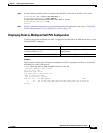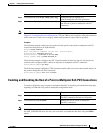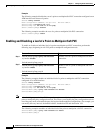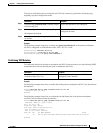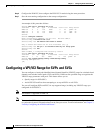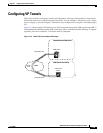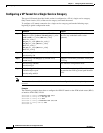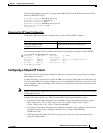
7-75
ATM Switch Router Software Configuration Guide
OL-7396-01
Chapter 7 Configuring Virtual Connections
Configuring Nondefault Well-Known PVCs
Configuring Nondefault PVCs
To configure the nondefault PVCs for signalling, ILMI, and PNNI, perform the following steps,
beginning in global configuration mode:
Note An error condition occurs if either the signalling or ILMI well-known VCs remain unconfigured when
an interface is enabled.
When you configure well-known VCs on physical interfaces using the CBR service category, the VC
scheduling on the external interface is the same as the CBR VC configuration. This means that the VCs
are allocated the bandwidth specified and are limited to that same bandwidth (shaped).
Note The connection from an external interface to the route processor is never shaped.
Example
The following example shows the nondefault VC configuration steps:
Step 1 Use the show atm vc interface atm command to display the configuration of the existing default
well-known VCs for ATM interface 0/0/0.
Step 2 Change to interface configuration mode for ATM interface 0/0/0.
Step 3 Enter manual well-known-vc mode and delete the existing default well-known VCs using the
atm manual-well-known-vc delete command.
Step 4 Confirm deletion by entering y.
Step 5 Configure the nondefault VC for signalling from 5 (the default) to 35 using the atm pvc command.
Command Purpose
Step 1
Switch(config)# interface atm card/subcard/port
Switch(config-if)#
Selects the interface to be configured.
Step 2
Switch(config-if)# atm manual-well-known-vc
{keep | delete}
Enters manual-well-known-vc mode.
Step 3
Switch(config-if)# atm pvc vpi vci [rx-cttr index]
[tx-cttr index] interface atm card/subcard/port
any-vci [encap {ilmi | pnni | qsaal}]
or
Switch(config-if)# tag-switching atm control-vc
vpi vci
Configures the nondefault PVC for encapsulation
type.
Step 4
Switch(config-if)# end
Switch#
Returns to privileged EXEC mode.
Step 5
Switch# copy system:running-config
nvram:startup-config
Copies the running configuration file to the
startup configuration file.



